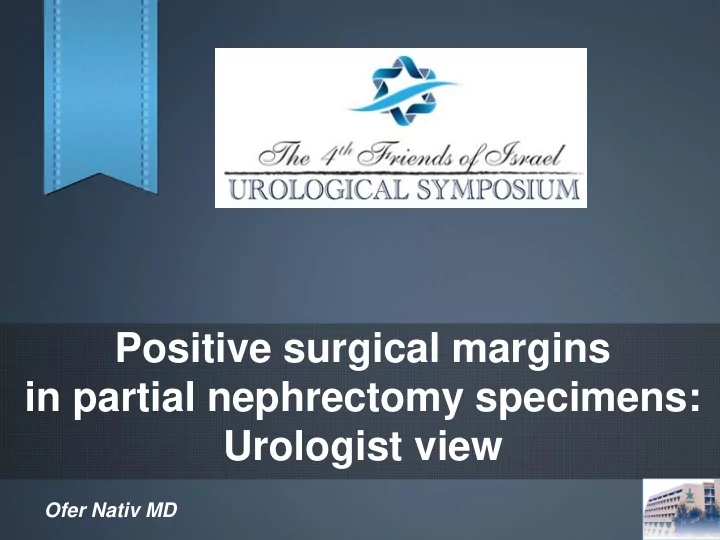

Positive surgical margins in partial nephrectomy specimens: Urologist view Ofer Nativ MD
Financial and Other Disclosures • Off-label use of drugs, devices, or other agents: None or FILL IN HERE; including your local regulatory agency, such as FDA, EMA, etc. • Data from IRB- approved human research is presented [or state: “is not”] I have the following financial interests or Disclosure code relationships to disclose: Pfizer C, L Novartis C, L J & J L Mel C Zeitic C GSK C, L 2
Introduction • In recent years, NSS for renal tumors has replaced RN as the standard procedure for treating localized RCC. • This change in surgical practice have resulted in increased rate of PSM. • The clinical relevance of PSM remains controversial.
Points for consideration • Definition. • Determination. • Rate. • Risk factors. • Clinical implications. • How to avoid PSM. • Management.
Risk factors for positive surgical margins
Tumor related risk factors • Size ( both large and small tumors ). • Stage. • Superior pole location ( for MIPN ). • High grade. • Complete pseudocapsule penetration. • Papillary and chromophobe types. • High complexity. • Multiple/Bilateral lesions.
• 800 pts. • 4,9% PSM. • 2009-2012. • 19 centers. Schiavina R et al’, Clinical Genitourinary Cancer, 2015
Parenchymal – tumor interface Intact PC Absent PC
Parenchymal – tumor interface Complete PC invasion Partial PC invasion
Surgery related risk factors • Open vs Minimally invasive. • Enucleation vs partial nephrectomy. • Clamped vs off-clamped ( ↑bleeding ). • Teaching programs (un-experience surgeons). • Academic vs community institutes. • Solitary kidney. • Imperative indication. • African American.
• The PSM rate ↑ over time PSM in patients with/without APF in all pts and in those with APF. • Time, older age, larger tumor, community hospital, and robotic approach were associated with PSM in the setting of APF. Maurice MJ et al’, BJUI, 2015
Trends in PSM for • Retrospective cT1a, cT1b, cT2a analysis. • US NCDB. • 2004 – 2013. • 43,749 PNs. • 6,8% PSM. cT1a - 6,9%, cT1b - 6,5%, cT2a - 6,25% Fero K et al”, BJUI, 2017
Trends in PSM: 2010 - 2013 PSM increased from 6,8% to 7,3% Use of MIPN stratified by clinical stage PSM for MIPN and OPN “…higher stage was not the main driver in terms 52,8% of risk of PSMs, but rather it was the Increased 69,6% adoption of minimally invasive approaches” 39,9% 59,6% 33,3% 47,3%
• Objective: To assess the relationship of race and margin status in patients undergoing RPN forT1 renal tumors. • Methods: Using the National Cancer Database, 12,515 patients with cT1 lesions treated between 2010-2013 were identified. • Results: PSM was 7,9% for white pts, 8,8% for hispano/latino pts and 10,8% for AA pts. In multivariate analysis AA pts and treatment at non- academic center were associated with PSM . Chen VS et al’, Urol Oncol, 2017
Clinical implications of positive surgical margins
Clinical implications of PSM • Variables studied: ‒ Local recurrence. ‒ Distant metastases. ‒ Cancer -specific survival. ‒ Overall survival. • The clinical and oncologic impact of PSMs after NSS is controversial.
Clinical implications of PSM Bensalah K et al’, Eur Urol, 2010 Shah PS et al’, J Urol, 2016
• Multicenter retrospective study. • 111 patients with PSM were compared with 664 NSM patients. • A second cohort of NSM patients was created by matching NSM to PSM for tumor size, grade and indication. • End points: ‒ LR . ‒ Cancer-specific survival . Bensalah K et al’, Eur Urol, 2010
Outcome LR-free survival Cancer-specific survival PSM following NSS may be associated with an increased risk of recurrence; however, it does not appear to influence cancer-specific survival.
• A retrospective multi-institutional study of 1,240 patients undergoing PN between 2006 and 2013. A positive margin was associated with an increased risk of relapse on multivariable analysis (HR 2.08) Shah PH et al’, J Urol, 2016
• A retrospective single institution study. • 1863 RCC pts underwent PN (1990-2015). • 1,8% PSM. • A 1:3 (34:100) matching was performed to a NSM cohort. • Median F-U: 62 months. • End points: ‒ Predictors of PSM. ‒ LR, Progression and survival. Petros FG et al’, WJUR, 2018
Clinical outcome of pts with and without PSM after NSS OS LR Free survival Distant Mets Mets Free survival Free survival
How to avoid positive surgical margins
How to avoid PSM • A thorough understanding of surgical anatomy. • Careful review of the pre-op. imaging. • Use of simulators. • Avoid intra-operative bleeding. • Intraoperative US to delineate tu’ anatomy. • Intraoperative FS from the tumor bed (?). • Fulguration of the resection bed by cautery or by argon-beam coagulator.
Review of the pre-op. imaging
Review of the pre-op. imaging
Review of the pre-op. imaging Coronal Axial
CT-based reconstruction of a 3-D model of left renal mass Chen Y et al’, WJUR 2014
Virtual simulation on the 3D image superimposed on model the 2D laparoscopic image
Intra-operative image guided surgery
A patient specific 3D model is reconstructed on A standard lap the basis of the trainer box and preop imaging. robotic instruments is used for the A 3-D model of simulation. the kidney and tumor is then Printed using mixtures of silicone rubber. von Rundstedt FC et al’, BJUI, 2016
Management of Positive surgical margins
Algorithm for management of PSM PSM Intra-op Post-op Resect Observe tu ’ bed Systemic LR No rec. Prog. Ablation TT/IO/Sx Observe
Summary • PSM is relatively rare. • PSM is associated with higher risk of local recurrence. • PSM may impact progression and cancer survival, mainly in high risk cases. • Efforts should be made to avoid PSM. • Close F-U is recommended for cases with PSM that are detected postoperatively.
Thanks
Recommend
More recommend